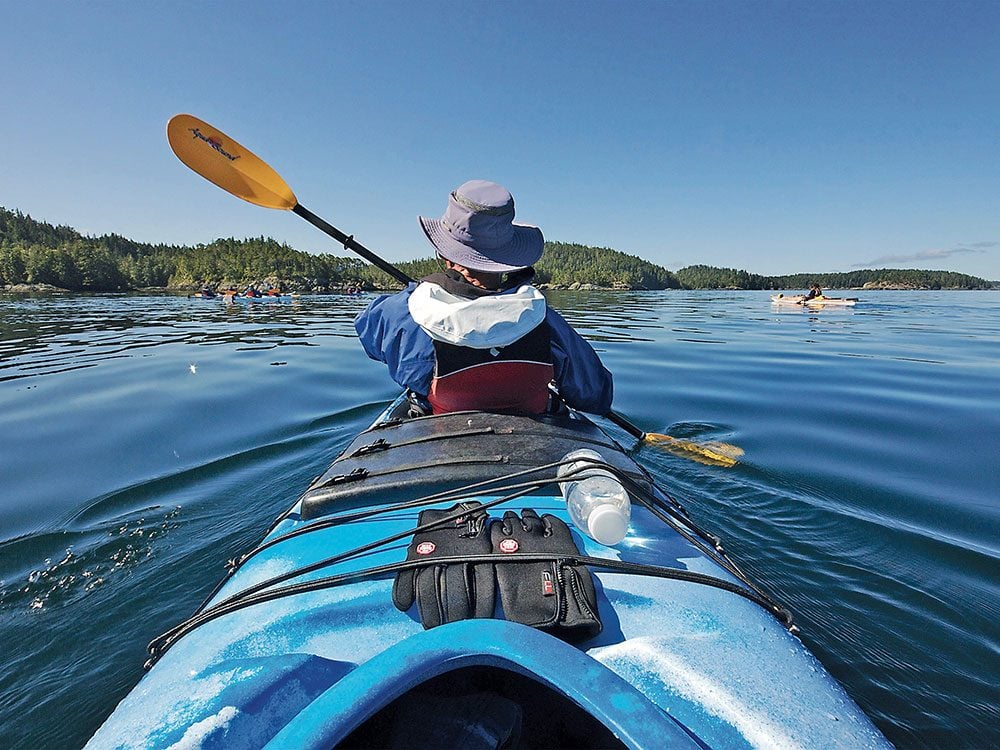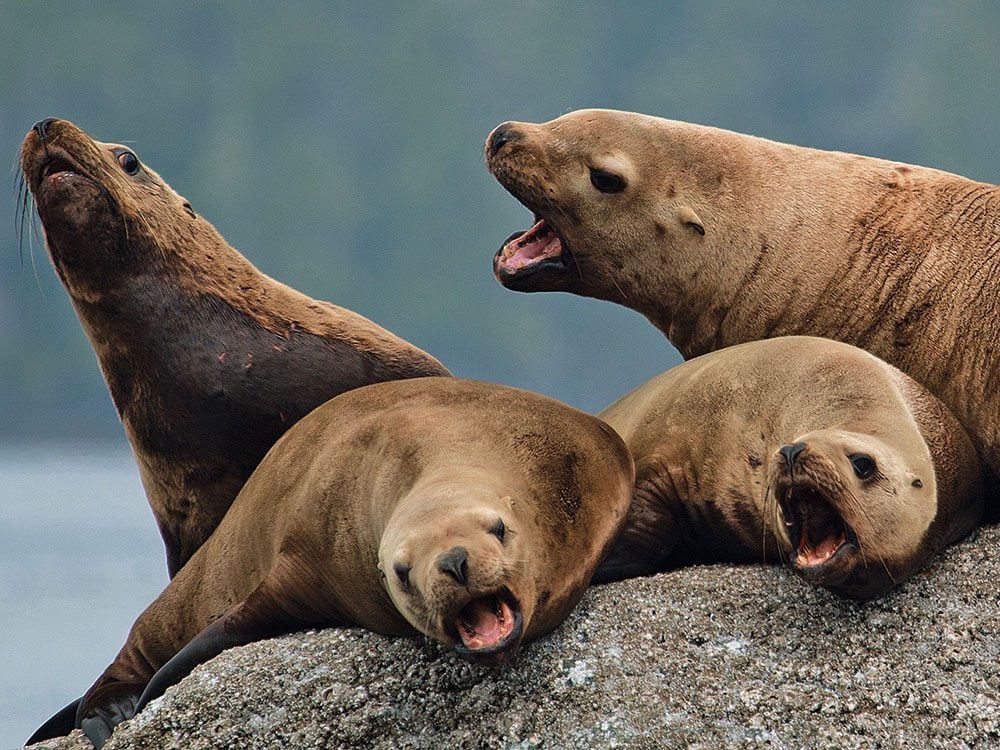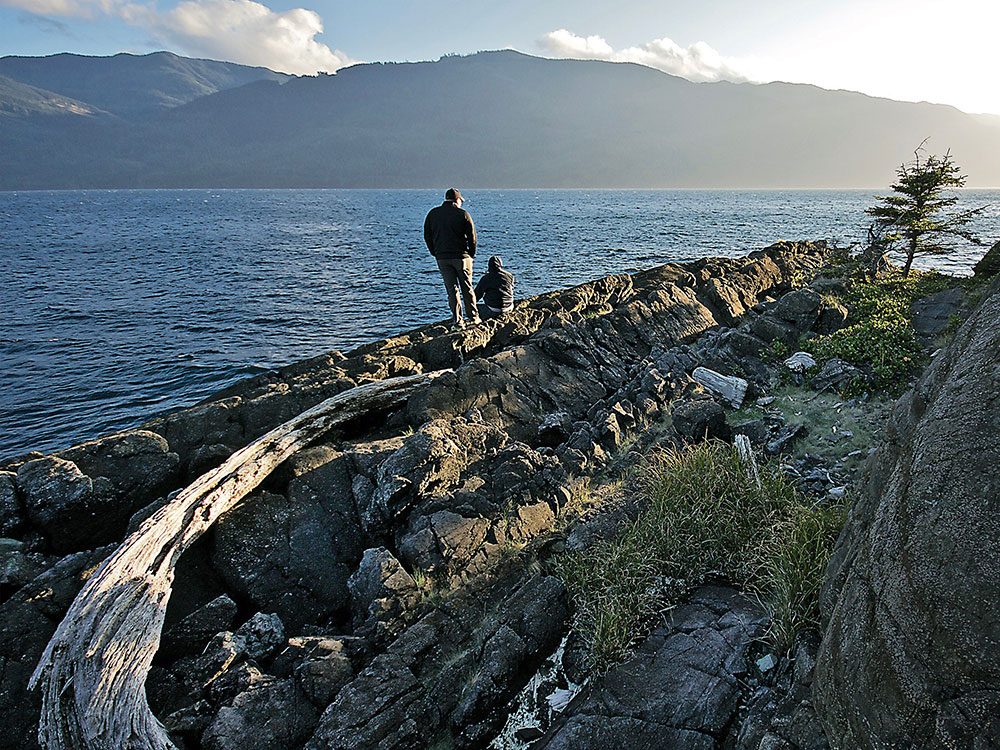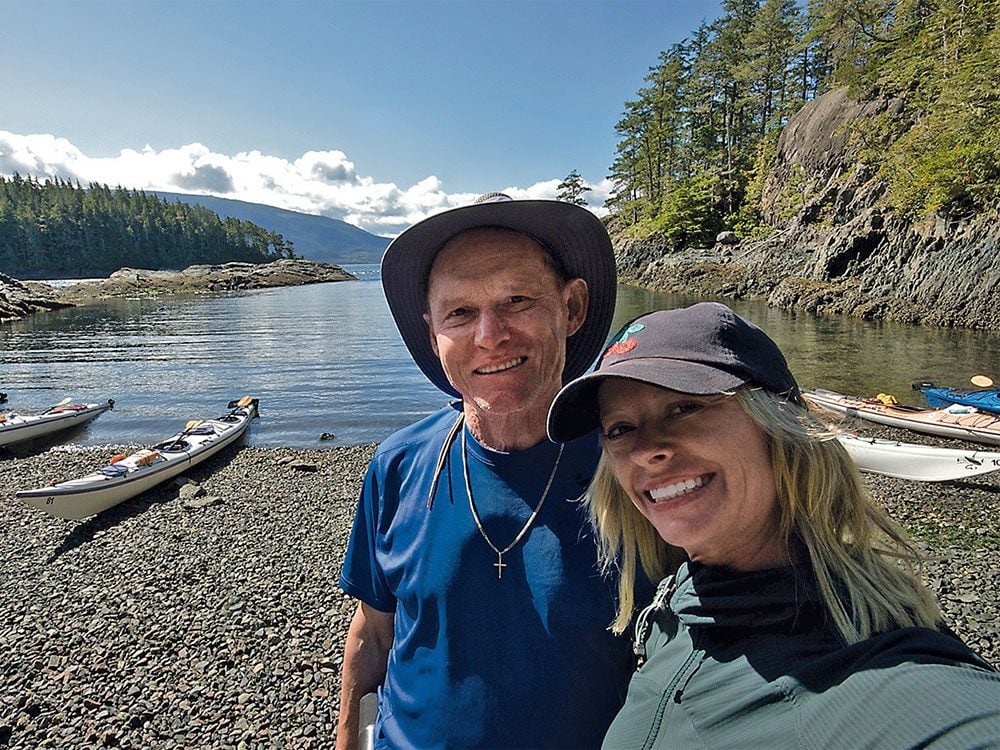
Kayaking in the Johnstone Strait
“Now this is living!” I yell to my father as another metre-high wave lifts our kayak and pushes it forward with ease.
The gusty wind roars in my ears. The salt water sprays my sun-drenched face. But I can’t stop laughing—a reaction I have whenever I’m barrelling down a roller coaster, gripped with fear, adrenaline and excitement all at the same time.
“I didn’t think we’d be surfing today,” replies my nervous father, concentrating on how to manoeuvre our tandem kayak through the turbulent waters in the Johnstone Strait—a narrow and major navigation channel separating Vancouver Island from the mainland.
Whitewater ocean kayaking isn’t what I had in mind when we signed up for a two-day overnight kayaking trip with North Island Kayak off the rugged north coast of Vancouver Island, but it was certainly setting the stage for one heck of an adventure.
I wound up on these choppy waters after a local resident told me the strait comes alive in late summer with humpback whales readying for their winter migration to Hawaii. The humpbacks migrate farther than any other mammal on Earth, according to the National Oceanic and Atmospheric Administration, travelling around 5,000 kilometres between their breeding and feeding grounds on a regular basis.

An abundance of marine life
The Johnstone Strait is also home to more than 200 northern resident killer whales, Steller sea lions, harbour seals, the Pacific white-sided dolphin, otters and porpoises, making it one of the best places to view marine life. Twenty kilometres south of Telegraph Cove is the only sanctuary for killer whales on Canada’s West Coast—the Robson Bight/Michael Biggs Ecological Reserve—a protected area where whales come to feed, socialize and rub themselves on barnacle-encrusted rocks, providing plenty of opportunities for scientists to study their behaviour.
Such an abundance of marine life is what prompted me to search for an overnight kayaking trip with my 67-year-old father, Brian, who grew up and still lives on Alberta’s prairies and had only been in an ocean kayak once for two hours. Since moving from Edmonton to Victoria in 2015, I had made it my mission to explore as much of the island as possible and was doing a good job of ticking off places on my lengthy list. Now it was time to include my father on an island adventure.
To my surprise, he immediately jumped at the chance to hop into a kayak again and experience the thrill of witnessing whales at eye level in a wild and ridiculously beautiful landscape shaped by rugged mountains and hundreds of islands coated with velvety trees.
Now here we are, paddling across the Johnstone Strait, trying not to lose our breakfast. We’re making our way to our wilderness camp for the night on Hanson Island—a tiny island located five kilometres from Vancouver Island, which sits at the heart of the northern resident killer whale summer range. Waves of excitement wash over me every time I look back and see my father in the kayak, even though he’s likely questioning what the heck he’s gotten himself into.
Halfway across the strait, the blow of a humpback whale goes off like a geyser in the distance, sending a ripple of excitement through our group of 12 kayakers and two guides. The buzz continues when another humpback appears near Hanson Island. This time it’s much closer, giving us the chance to hear it breathe and see its shiny black dorsal fin and large tail before it heads down for a deep dive that can last 15 to 30 minutes. These giants, which can grow to 18 metres and weigh 36 tonnes, have lungs the size of a small car. It’s a creepy yet exhilarating feeling knowing an animal the size of a small plane is swimming somewhere beneath you.
Find out why Calvert Island is B.C.’s answer to the Caribbean.

Soaking up the scenery on the Johnstone Strait
It isn’t until we’ve tackled the ferocious afternoon waves and are feasting on a salmon dinner at camp that our group spots a small pod of killer whales not far from shore. Eyes glued to the water, I watch them surface multiple times until they’re no longer in sight. The blows of more humpbacks explode in the distance, keeping the audience captivated and wondering what will pop up next.
“The area I paddle in really is the place for wildlife viewing. We say it turns into whale soup during the best part of the season,” says our guide Dan Smetaniuk, who’s originally from Edmonton and started guiding in the area in 2017.
“My first time paddling on the Johnstone Strait, I was blown away by the beauty of the area. Everyone wants to see whales, but there are many types of marine mammals, birds and other critters. The intertidal life is amazing and all you need to do is look down,” says Dan.
The next morning, I’m relieved to see the water is perfectly calm under clear sunny skies, paving the way for a relaxing paddle around the remainder of Hanson Island and into Blackfish Sound.
“Are you ready for round two?” I ask my father, as we push back into the ocean.
“I’m always ready,” he replies with an uncertain look on his face. It’s hard to tell whether he’s nervous or excited about another day of paddling after the white water fiasco that left many in our group shaken.
This time our kayak glides effortlessly through the first stretch of sheltered water, where we scan the coastline looking for intertidal and marine life. It’s a peaceful setting. The only sound is our paddles gently dipping into the water and the occasional bird squawking somewhere in the distance.
Discover the best wildlife experiences across Canada.

New and unfamiliar adventures
The silence is quickly shattered by a loud snort from one of three large and curious sea lions that suddenly surface and start swimming beside our group. The average male sea lion weighs around 550 kilograms, making them hard to miss when they’re only a metre or so away.
Around the corner is the rest of the pack basking in the sun on a small open patch of the rocky shoreline. A chorus of growls erupts the moment they notice our presence, prompting our guides to warn us not to get too close.
“How does that grab you, Pamela?” asks my father, with a permanent smile glued to his face as he soaks in the magical display of wildlife both in and out of the water.
As we near the end of our journey, passing more harbour seals and bald eagles along the way, I can’t help but feel proud of my father for tackling a new, unfamiliar adventure. We’ve been to Rwanda to track wild mountain gorillas in the jungle, cruised through the Canadian Rockies on a luxury passenger train and spent many hours exploring the mountains around Jasper and Banff National Park. But this was different.
Being in a kayak on the open ocean makes you feel vulnerable at times and is physically challenging as well. My father demonstrated that you’re never too old to try something new, even though it might not always be smooth sailing.
“The whole experience was unforgettable. The sights, sounds and scenery bombarded the senses from start to finish,” says my father once we return to Telegraph Cove and bid farewell to our mighty kayak packed with overnight gear. “It really does make you feel alive and connected to nature.”
Now that you’ve added kayaking in the Johnstone Strait to your bucket list, check out the 10 national parks every Canadian needs to visit.